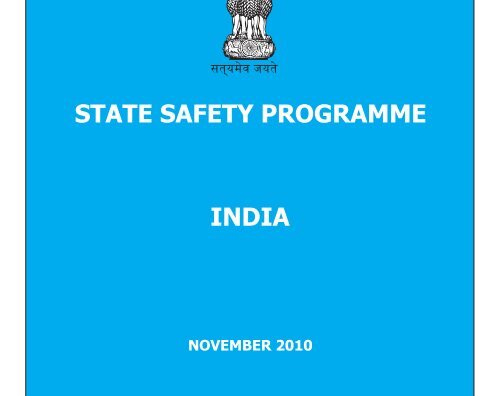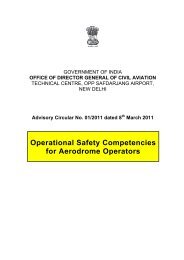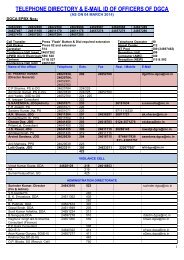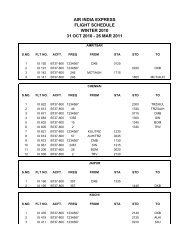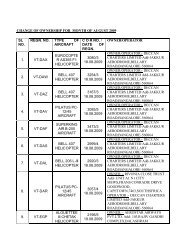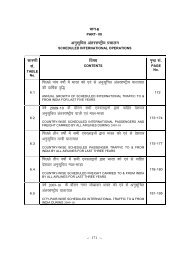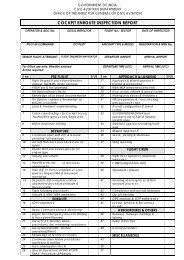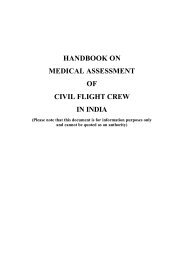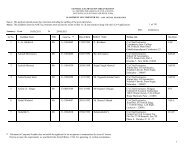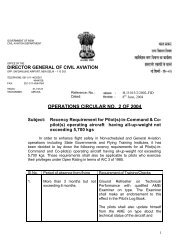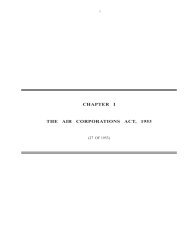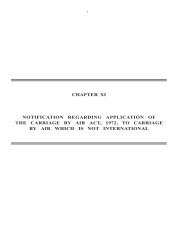State Safety Programme - India - Directorate General of Civil Aviation
State Safety Programme - India - Directorate General of Civil Aviation
State Safety Programme - India - Directorate General of Civil Aviation
Create successful ePaper yourself
Turn your PDF publications into a flip-book with our unique Google optimized e-Paper software.
सत्यमेव जयतेSTATE SAFETY PROGRAMMEINDIANOVEMBER 2010
<strong>State</strong> <strong>Safety</strong> <strong>Programme</strong> - <strong>India</strong><strong>State</strong> <strong>Safety</strong> <strong>Programme</strong> <strong>India</strong>This Edition November 2010<strong>Directorate</strong> <strong>General</strong> <strong>of</strong> <strong>Civil</strong> <strong>Aviation</strong>Ministry <strong>of</strong> <strong>Civil</strong> <strong>Aviation</strong>, New Delhi,<strong>India</strong>iiNovember 2010
<strong>State</strong> <strong>Safety</strong> <strong>Programme</strong> - <strong>India</strong>STATE SAFETY PROGRAMMEINDIANOVEMBER 2010<strong>Directorate</strong> <strong>General</strong> <strong>of</strong> <strong>Civil</strong> <strong>Aviation</strong>Ministry <strong>of</strong> <strong>Civil</strong> <strong>Aviation</strong>, New Delhi,<strong>India</strong>November 2010
<strong>State</strong> <strong>Safety</strong> <strong>Programme</strong> - <strong>India</strong>Contents1. INTRODUCTION ..................................................................31.1 Purpose .................................................................................41.2 Definitions .............................................................................41.3 Document control....................................................................62. STATE SAFETY OVERSIGHT SYSTEM...................................72.1 Introduction ............................................................................72.2 <strong>General</strong> <strong>India</strong> as ICAO Contracting <strong>State</strong> ..................................72.3 Responsibilities <strong>of</strong> the MOCA ....................................................72.4 Responsibilities <strong>of</strong> the DGCA.....................................................82.5 Accident Investigation..............................................................92.6 Search and Rescue ................................................................102.7 <strong>Civil</strong> Military Cooperation .......................................................103. STATE SAFETY POLICY AND OBJECTIVES........................113.1 <strong>India</strong>'s aviation safety legislative framework.............................113.1.1 Monitoring and review <strong>of</strong> legislative framework and specificregulations............................................................................133.2 SSP responsibilities and accountabilities ..................................14November 2010iii
<strong>State</strong> <strong>Safety</strong> <strong>Programme</strong> - <strong>India</strong>3.3 Accident and incident investigation ..........................................153.4 Enforcement Policy ................................................................164. STATE SAFETY RISK MANAGEMENT .................................194.1 Introduction..........................................................................194.2 <strong>Safety</strong> requirements for the service provider's SMS ..................204.3 Performance-based safety ......................................................224.3.1 <strong>State</strong> Acceptable Level <strong>of</strong> <strong>Safety</strong> (ALoS)........................224.3.2 Agreement on service providers' safety performance......234.3.3 Derivation <strong>of</strong> <strong>Safety</strong> Plan to deliver the safety targets ....244.4 <strong>India</strong> implementation <strong>of</strong> SSP ...........................................245. STATE SAFETY ASSURANCE ..............................................275.1 <strong>Safety</strong> oversight ....................................................................275.2 <strong>Safety</strong> data collection, analysis and exchange..........................285.2.1 Mandatory Occurrence Reporting System (MORS) ...........295.2.2 Voluntary Reporting System (VRS) .................................305.2.3 Mandatory Bird Strike Reports .......................................305.2.4 Reporting and investigation <strong>of</strong> aircraft proximity incidents...........................................................................................305.2.5 Reporting and investigation <strong>of</strong> defects in aircraft andaircraft components ...............................................................31ivNovember 2010
<strong>State</strong> <strong>Safety</strong> <strong>Programme</strong> - <strong>India</strong>5.2.6 Using safety data to target oversight on areas <strong>of</strong> greaterconcern or need ....................................................................316. STATE SAFETY PROMOTION .............................................336.1 Internal training, communication and dissemination <strong>of</strong>safety information .................................................................336.2 External training, communication and dissemination <strong>of</strong>safety information .................................................................35Table <strong>of</strong> FiguresFigure 1. The regulatory framework in <strong>India</strong>...........................12Figure 2. The relationships between the <strong>State</strong> SSP and the serviceproviders SMS ....................................................................19Figure 3. ALoS development process.....................................48November 2010v
<strong>State</strong> <strong>Safety</strong> <strong>Programme</strong> - <strong>India</strong>INTENTIONALLY LEFT BLANKviNovember 2010
<strong>State</strong> <strong>Safety</strong> <strong>Programme</strong> - <strong>India</strong>ForewordInternational <strong>Civil</strong> <strong>Aviation</strong> Organization (ICAO) place responsibilityon Contracting <strong>State</strong>s to formulate a <strong>State</strong> <strong>Safety</strong> <strong>Programme</strong> (SSP).The <strong>Programme</strong> is an integrated set <strong>of</strong> Regulations and activitiesaimed at improving safety. <strong>Directorate</strong> <strong>General</strong> <strong>of</strong> <strong>Civil</strong> <strong>Aviation</strong>(DGCA) has regulatory responsibility for aviation safety.The SSP is based on comprehensive analysis <strong>of</strong> the <strong>State</strong>'s aviationsystem, safety policies and risk management, safety assurance andpromotion. <strong>Safety</strong> oversight <strong>of</strong> DGCA is now focused on areas <strong>of</strong>significant safety concerns or higher safety risks. Thus, SSP providesthe means to combine prescriptive and performance-basedapproaches to safety rulemaking, policy development and oversightby DGCA <strong>India</strong>.In order to manage the SSP and ensure implementation <strong>of</strong>requirements <strong>of</strong> <strong>Safety</strong> Management Systems (SMS) by stakeholders,a <strong>State</strong> <strong>Safety</strong> <strong>Programme</strong> and <strong>Safety</strong> Management Systems(SSP/SMS) Division has been established in DGCA. A regulatoryframework after introduction <strong>of</strong> SSP in DGCA and SMS amongststakeholders has been established.Most <strong>of</strong> the essential elements <strong>of</strong> the safety framework are wellestablished. However, a number <strong>of</strong> items have been identified forimprovement which need further concentrated efforts to work uponin related areas. Various tasks outlined in the <strong>Programme</strong> need to becompleted by concerned <strong>of</strong>ficials to make SSP a wholesome subjectunder DGCA. It is for this reason that it is planned to keep thisdocument up-to-date on DGCA website. DGCA will work with serviceproviders in cooperative and collaborative manner to help themdevelop and establish their SMS.I would like to thank and appreciate the members <strong>of</strong> <strong>India</strong> SSP forundertaking and accomplishing this task in time.Dr. Nasim ZaidiDirector <strong>General</strong> <strong>of</strong> <strong>Civil</strong> <strong>Aviation</strong><strong>Directorate</strong> <strong>General</strong> <strong>of</strong> <strong>Civil</strong> <strong>Aviation</strong> <strong>India</strong>November 2010vii
<strong>State</strong> <strong>Safety</strong> <strong>Programme</strong> - <strong>India</strong>INTENTIONALLY LEFT BLANKviiiNovember 2010
<strong>State</strong> <strong>Safety</strong> <strong>Programme</strong> - <strong>India</strong>GlossaryAcronymAAIAICAIPAcsADREPALoSAIRPROXAIRSARAPBFASCARsCASACCSISDGCAECCAIRSFAAFDMFIRFOQAFUAIASAICAOMOCADefinitionAirports Authority <strong>of</strong> <strong>India</strong>Aeronautical Information CircularAeronautical Information PublicationAdvisory CircularsAccident Data ReportingAcceptable Level <strong>of</strong> <strong>Safety</strong>Airproximity incidentAccident Incident Reporting System<strong>Aviation</strong> Regulatory Advisory PanelBoard for <strong>Aviation</strong> <strong>Safety</strong><strong>Civil</strong> <strong>Aviation</strong> Requirements<strong>Civil</strong> <strong>Aviation</strong> <strong>Safety</strong> Advisory CouncilComprehensive <strong>Safety</strong> Information System<strong>Directorate</strong> <strong>General</strong> <strong>of</strong> <strong>Civil</strong> <strong>Aviation</strong>European Coordination Centre on <strong>Aviation</strong> IncidentReporting SystemFederal <strong>Aviation</strong> AdministrationFlight Data MonitoringFlight Information RegionFlight Operations Quality AssuranceFlexible Use <strong>of</strong> AirspaceInternational <strong>Aviation</strong> <strong>Safety</strong> AssessmentsInternational <strong>Civil</strong> <strong>Aviation</strong> OrganisationMinistry <strong>of</strong> <strong>Civil</strong> <strong>Aviation</strong>November 2010 1
<strong>State</strong> <strong>Safety</strong> <strong>Programme</strong> - <strong>India</strong>MORSNBCCNOTAMRQMSSARSARP’sSMSSSPQMSVRSMandatory Occurrence Reporting SystemNational Bird Control CommitteeNotice to AirmenRegulatory and Quality Management SystemSearch and RescueICAO Standards and Recommended Practices andProcedures<strong>Safety</strong> Management System<strong>State</strong> <strong>Safety</strong> <strong>Programme</strong>Quality Management SystemVoluntary Reporting System2November 2010
<strong>State</strong> <strong>Safety</strong> <strong>Programme</strong> - <strong>India</strong>1. INTRODUCTIONInternational <strong>Civil</strong> <strong>Aviation</strong> Organization (ICAO) defines safety as thestate in which the risk <strong>of</strong> harm to persons or <strong>of</strong> property damage isreduced to, and maintained at or below, an acceptable level througha continuing process <strong>of</strong> hazard identification and risk management.ICAO's Standards and Recommended Practices (SARPs) (Annexes tothe Convention on International <strong>Civil</strong> <strong>Aviation</strong>: Annex 1 (PersonnelLicensing), 6 (Operation <strong>of</strong> Aircraft, Part I - InternationalCommercial Air Transport - Aeroplanes and Part III - InternationalOperations - Helicopters), 8 (Airworthiness <strong>of</strong> Aircraft), 11 (AirTraffic Services), 13 (Aircraft Accident and Incident Investigation),and 14 (Aerodromes) require that <strong>State</strong>s establish a <strong>State</strong> <strong>Safety</strong><strong>Programme</strong> (SSP) to achieve an Acceptable Level <strong>of</strong> <strong>Safety</strong> (ALoS) incivil aviation operations.ICAO Standards explicitly require that <strong>State</strong>s establish an ALoS as ameans to verify satisfactory performance <strong>of</strong> the SSP and serviceproviders' <strong>Safety</strong> Management Systems (SMS). ICAO describes anSSP as "an integrated set <strong>of</strong> regulations and activities aimed atimproving safety."The requirement for an SSP recognises that <strong>State</strong>s as well as serviceproviders have safety responsibilities and provides a frameworkwithin which service providers are required to establish SMS.The ICAO SARPs contained in Annexes 1, 6, 8, 11 and 14 addressthe activities related to service providers such as:§ approved training organizations that are exposed to safetyrisks during the provision <strong>of</strong> their services,§ aircraft operators,November 2010 3
<strong>State</strong> <strong>Safety</strong> <strong>Programme</strong> - <strong>India</strong>§ approved maintenance organizations,§ organizations responsible for type design and/or manufacture<strong>of</strong> aircraft,§ air traffic services providers, and§ Certified aerodromes.<strong>India</strong> SSP is broad in scope, including many safety activities aimed atfulfilling the programme's objectives <strong>of</strong> civil aviation.The SSP document has been developed using the ICAO framework andguidance material, including the ICAO SSP gap analysis document andinternational best practice.1.1 PurposeThe purpose <strong>of</strong> this document is to communicate the SSP for civilaviation in <strong>India</strong> to all stakeholders. This focuses on roles andresponsibilities, as well as actions taken by the <strong>Directorate</strong> <strong>General</strong><strong>of</strong> <strong>Civil</strong> <strong>Aviation</strong> (DGCA), as the responsible organisation for the <strong>State</strong>safety in civil aviation.1.2 DefinitionsFor the purposes <strong>of</strong> this document:A hazard is any situation or condition that has the potential to causedamage or injury.Risks are the potential adverse consequences <strong>of</strong> a hazard, and areassessed in terms <strong>of</strong> their severity and likelihood.4November 2010
<strong>State</strong> <strong>Safety</strong> <strong>Programme</strong> - <strong>India</strong>Mitigation - measures or controls put in place to either eradicatethe hazard, or to reduce the severity or likelihood <strong>of</strong> the assessedrisks.<strong>State</strong> <strong>Safety</strong> <strong>Programme</strong> means an integrated set <strong>of</strong> regulationsand activities aimed at improving safety.<strong>Safety</strong> indicators: “the parameters that characterize and/or typifythe level <strong>of</strong> safety <strong>of</strong> a system”.<strong>Safety</strong> performance indicator is a measure (or metric) used toexpress the safety performance in a system.<strong>Safety</strong> targets: “the concrete objectives <strong>of</strong> the level <strong>of</strong> safety”.<strong>Safety</strong> performance target comprises one or more safetyperformance indicators, together with desired outcomes expressed interms <strong>of</strong> those indicators. (ICAO Doc.9859 <strong>Safety</strong> ManagementManual describes safety performance indicators and safetyperformance targets within the concept <strong>of</strong> an "acceptable level <strong>of</strong>safety".)<strong>Safety</strong> requirements are the steps that need to be taken tochieve the safety performance targets. They include the operationalprocedures, technology systems and programmes to which measures<strong>of</strong> reliability, availability, performance and/or accuracy can bespecified.Acceptable level <strong>of</strong> safety: “the minimum degree <strong>of</strong> safety that mustbe assured by a system in actual practice”.<strong>Safety</strong> Measurement: is generally associated with the SSP and refersto the “quantification <strong>of</strong> the outcomes <strong>of</strong> selected high-level,high consequence events, such as accident and serious incidentNovember 2010 5
<strong>State</strong> <strong>Safety</strong> <strong>Programme</strong> - <strong>India</strong>continuous process. It is considered a “spot check” conducted at periodicintervals.<strong>Safety</strong> Performance Measurement: is generally associated with anSMS and refers to the “quantification <strong>of</strong> the outcomes <strong>of</strong> selected lowlevel,low consequence processes” such as the number <strong>of</strong> unauthorizedground vehicle events on taxiways per a specific number <strong>of</strong> airportoperations. <strong>Safety</strong> performance measurement is tactical in nature and isa “non-stop activity, involving continuous monitoring and measurement”.1.3 Document controlThe SSP document will be made available to all regulatory staff havingsafety oversight responsibilities by the Information and Regulation<strong>Directorate</strong>. The document shall also be placed on DGCA website(http://dgca.nic.in/).Changes to this document will be achieved by a re-issue <strong>of</strong> the entiredocument rather than by the amendment <strong>of</strong> individual pages.The SSP document will be reviewed periodically by Director-<strong>General</strong> atleast annually to ensure the relevance and currency <strong>of</strong> all legislation,regulations, DGCA requirements etc.6November 2010
<strong>State</strong> <strong>Safety</strong> <strong>Programme</strong> - <strong>India</strong>2. STATE SAFETY OVERSIGHT SYSTEM2.1 IntroductionThe purpose <strong>of</strong> this section is to describe the safety oversightarrangements in place in <strong>India</strong> as an ICAO Contracting <strong>State</strong>. Itexplains the relationships between DGCA, as the body responsiblefor SSP, and the Government <strong>of</strong> <strong>India</strong> and ultimately ICAO. Thissection also references the different aviation regulatory framework inplace in <strong>India</strong>.2.2 <strong>General</strong> <strong>India</strong> as ICAO Contracting <strong>State</strong><strong>India</strong> ratified the Convention on International <strong>Civil</strong> <strong>Aviation</strong> (thestChicago Convention) on 1 March 1947.The Ministry <strong>of</strong> <strong>Civil</strong> <strong>Aviation</strong> (MOCA), Government <strong>of</strong> <strong>India</strong>, isresponsible for civil aviation in <strong>India</strong> and for upholding <strong>India</strong>'scompliance with the Chicago Convention. The MOCA establishes theoverall aviation policy for civil aviation in <strong>India</strong>.The DGCA is the overall safety regulator <strong>of</strong> the civil aviation.2.3 Responsibilities <strong>of</strong> the MOCAThe Ministry <strong>of</strong> <strong>Civil</strong> <strong>Aviation</strong> (MOCA) is the nodal Ministryresponsible for policy formulation and regulation <strong>of</strong> civil aviation in<strong>India</strong>. The Ministry also overlooks the planning and implementation<strong>of</strong> schemes for the growth and expansion <strong>of</strong> civil air transport,airport facilities, air traffic services and carriage <strong>of</strong> passengers andgoods by air.The Ministry <strong>of</strong> <strong>Civil</strong> <strong>Aviation</strong> (MOCA) is responsible for the overallpolicy direction in the field <strong>of</strong> civil aviation and is the executive headNovember 2010 7
<strong>State</strong> <strong>Safety</strong> <strong>Programme</strong> - <strong>India</strong><strong>of</strong> the MOCA and responsible to the Parliament for all civil aviationmatters.The MOCA is responsible for developing and amending primaryaviation legislation (The Aircraft Act, 1934). MOCA after consultationwith the other concerned Ministries and Ministry <strong>of</strong> Law, puts up theproposal to the Cabinet for approval. After a Cabinet approval, a Billis moved in Parliament and is passed in both Houses. The Billbecomes an Act after the President gives his assent to it. In theevent <strong>of</strong> Parliament not being in session and the amendment isconsidered urgent, the Government can get an Ordinance issued bythe President, which has the same force <strong>of</strong> law as an Act.Provisions contained in sections 4, 5, and 7 <strong>of</strong> the Aircraft Act, 1934empower Central Government to make Rules to implement theChicago Convention, 1944 (including any annex thereto relating tointernational standards and recommended practices and amendedfrom time to time) by notification in the Official Gazette.2.4 Responsibilities <strong>of</strong> the DGCAThe DGCA is responsible for the safety regulation <strong>of</strong> the civil aviationindustry and is recognised in the Aircraft Act and the Aircraft Rulesas regulatory authority for civil aviation.The Director-<strong>General</strong> has special powers vested under Section 5A <strong>of</strong>the Act to issue directions. Section 4A <strong>of</strong> the Aircraft Act empowersthe Director-<strong>General</strong> or any other <strong>of</strong>ficer specially empowered in thisbehalf by the Central Government to perform the safety oversightfunctions in respect <strong>of</strong> matters specified in the Act or the rules madethereunder.The Aircraft Rules, 1937, provide a number <strong>of</strong> functions to DGCArelating to the issue <strong>of</strong> licenses, certificates, approvals and permits.The standards that applicants are expected to meet in order to begranted a license, certificate, approval or permission are contained inregulations termed as the <strong>Civil</strong> <strong>Aviation</strong> Requirements (CARs) issued6November 2010
<strong>State</strong> <strong>Safety</strong> <strong>Programme</strong> - <strong>India</strong>by DGCA under Rule 133A. Rule 29C <strong>of</strong> the Aircraft Rules, 1937,provides the power to the Director-<strong>General</strong> to lay down standardsand procedures to carry out the Convention and any Annex thereto.The Aircraft Rules also empowers persons authorised by DGCA toenter, inspect and search any aircraft or any aviation facility,including air navigation services, and also inspect any personnel,document and records for the purpose <strong>of</strong> securing compliance withany <strong>of</strong> the rules or the provisions <strong>of</strong> the Aircraft Act, 1934.The DGCA is also responsible for the safety oversight <strong>of</strong> foreignaircraft while operating in <strong>India</strong>.2.5 Accident InvestigationPart X and X-A <strong>of</strong> the Aircraft Rules, 1937, provide for investigation<strong>of</strong> accidents and incidents respectively. The accidents areinvestigated by Inspector <strong>of</strong> Accidents, Committee <strong>of</strong> Inquiry or'Court'. While the Director-<strong>General</strong> appoints the Inspector <strong>of</strong>Accident, the Committee or the Court is appointed by the CentralGovernment. Director-<strong>General</strong>, when due to seriousness <strong>of</strong> theincident considers it expedient, may appoint an Inquiry Officer toinvestigate an incident.The Accident Report is submitted to the Director-<strong>General</strong> in case <strong>of</strong>investigation by an Inspector <strong>of</strong> Accident or an Inquiry Officer. Theaircraft rules require that the report <strong>of</strong> Inspector <strong>of</strong> Accident orInquiry Officer shall be forwarded to the Central Government by theDirector-<strong>General</strong> with such comments as he may think fit to make.The Committee <strong>of</strong> Inquiry/ Court submit the report to the CentralGovernment.In all cases <strong>of</strong> accident and incident investigations, the aircraft rulesprovides that only the Central Government may, at its discretion,make the whole or part <strong>of</strong> any such report public in such manner asit may consider fit, thereby ensuring the process <strong>of</strong> accident andNovember 2010 9
<strong>State</strong> <strong>Safety</strong> <strong>Programme</strong> - <strong>India</strong>incident investigation independent from the other aviationorganisations including the regulatory authority (DGCA).The aircraft rules further provide that where it appears to the CentralGovernment that any new and material evidence has becomeavailable after the completion <strong>of</strong> the investigation, it may by order,direct the reopening <strong>of</strong> the same, which further ensures that theprocess <strong>of</strong> accident and incident investigation is independent fromother aviation organisation <strong>of</strong> <strong>India</strong>.2.6 Search and RescueThe responsibility for co-ordination <strong>of</strong> search and rescue (SAR) withother agencies is vested with the Airports Authority <strong>of</strong> <strong>India</strong> (AAI)under the Airports Authority <strong>of</strong> <strong>India</strong> Act, 1994 (as amended by AAI(Amendment) Act 2003).2.7 <strong>Civil</strong> Military CooperationIn <strong>India</strong>, the model <strong>of</strong> side-by-side operations is being used as theairspace is demarcated between the civil and military authorities andthe Air Traffic Services are provided separately by the civil and militaryauthorities in their respective airspaces. The military authorities havebeen exclusively using the airspace specially allocated to them forcarrying out their own flying activities.In the flexible use <strong>of</strong> airspace, the airspace available with bothmilitary and civil users is effectively utilized on sharing basis to gainoptimum usage thereby enhancing its capacity and derive economicbenefits to flights operating within a nation's airspace. In this modela co-ordination procedure between the civil and the militaryauthorities is required for sharing <strong>of</strong> the airspace for meeting theoperational requirement <strong>of</strong> the military as well as demand <strong>of</strong> the civilaircraft operation.10November 2010
<strong>State</strong> <strong>Safety</strong> <strong>Programme</strong> - <strong>India</strong>3. STATE SAFETY POLICY AND OBJECTIVESThe vision <strong>of</strong> DGCA is to 'Endeavour to promote safe and efficient airtransportation through regulation and proactive safety oversightsystem'. To meet this vision, the DGCA has laid down its <strong>Safety</strong>Policy, attached as Appendix 2.In addition, this Policy has been placed on DGCA's website(http://dgca.nic.in/)3.1 <strong>India</strong>'s aviation safety legislative frameworkThe appropriate legislative framework for safety management hasbeen implemented in <strong>India</strong> in accordance with ICAO SARPs. Thislegal structure assigns responsibilities and gives the appropriateauthority to the DGCA to implement the applicable standards andrecommended practices. The Director-<strong>General</strong> is accountable for theeffective implementation <strong>of</strong> these responsibilities and authority.The management <strong>of</strong> aviation safety is carried out through acomprehensive regulatory framework with the Aircraft Act, 1934, asthe primary aviation legislation, the Aircraft Rules, 1937, and theAircraft (Carriage <strong>of</strong> Dangerous Goods) Rules, 2003. Also, in form <strong>of</strong>the operating regulations, through the CARs, AeronauticalInformation Circular (AIC) and Aeronautical Information Publication(AIP).For carrying out the ICAO Convention, 1944 (including any Annexthereto relating to international standards and recommendedpractices), <strong>India</strong> has three layers <strong>of</strong> legislation, this is shown onFigure 1.The Aircraft Act, 1934 is the Primary Legislation that empowers andprovides authority to implement other statutes as stipulated in theextent and scope <strong>of</strong> the Act. Section 4 <strong>of</strong> the Act provides power <strong>of</strong>November 2010 11
<strong>State</strong> <strong>Safety</strong> <strong>Programme</strong> - <strong>India</strong>Central Government to make rules to implement the Convention <strong>of</strong>1944.The Central Government has also promulgated Rule 29C <strong>of</strong> theAircraft Rules, 1937, regarding “Adoption <strong>of</strong> the Convention andAnnexes” and states that the Director-<strong>General</strong> may lay downstandards and procedures not inconsistent with the Aircraft Act,1934, and the rules made thereunder to carry out the Conventionand any Annex thereto. The Aircraft Rules, 1937 and CARs are theoperating regulations in the field <strong>of</strong> civil aviation in <strong>India</strong>.Notwithstanding the above, the Rules provide DGCA powers to grantcertificates, licences, and approvals for operations in civil aviation.The CARs provide the detailed requirements to be met that form ameans <strong>of</strong> compliance with ICAO SARPs that is consistent with thelegislation in force. Although CARs provide the comprehensiverequirements, there is a need to promulgate adequate informationwhich may not be appropriate for inclusion in the CARs. Suchinformation and guidance material for compliance with Rules andregulations is included in Advisory Circulars (Acs).The AircraftAct, 1934Section 4, empowers CentralGovernment (MOCA) to makeRules to carry out the ICAOConventionThe AircraftRules, 1937Rule 29C, empowers DGCA tomake CARs to adopt SARPs<strong>Civil</strong> <strong>Aviation</strong>Requirements(CARs)DGCA has promulgated manyCARs to carry out the ICAOConventionFigure 1. The regulatory framework in <strong>India</strong>12November 2010
<strong>State</strong> <strong>Safety</strong> <strong>Programme</strong> - <strong>India</strong>The regulatory framework enables the fulfilment <strong>of</strong> the obligations <strong>of</strong><strong>India</strong> under the Chicago Convention, 1944, within the <strong>State</strong>. Moredetailed information about the legal framework may be found at DGCAWebsite: http://dgca.gov.in.The regulatory framework provides consistency and compliance with theAnnexes to the Convention, 1944, wherever practicable. Differences, ifany, to standards and recommended practices <strong>of</strong> the Annexes, are filedto ICAO as per Article 38 <strong>of</strong> the Convention.3.1.1 Monitoring and review <strong>of</strong> legislative framework andspecific regulations<strong>India</strong> continues to review, develop and promulgate a national safetylegislative framework and specific regulations in compliance withinternational standards. Changes required in legislation to ensure theeffectiveness <strong>of</strong> the oversight system are determined through ongoingsafety analysis:a) The Oversight <strong>of</strong> the regulatory framework: Theregulatory framework is monitored continuously by DGCA inthe course <strong>of</strong> its usual regulatory business.b) Maintenance <strong>of</strong> the regulatory framework: The DGCA isresponsible for the administration necessary to maintain theregulatory framework. The DGCA has suitable procedures andis adequately resourced (staffed, funded etc), for the longerterm, to fulfil this task.c) The system <strong>of</strong> monitoring release <strong>of</strong> amendments to ICAOAnnexes has been institutionalized wherein these aremonitored on a continuous basis for timely inclusion in theregulations.d) The DGCA has set up standing <strong>Aviation</strong> Regulatory AdvisoryPanel (ARAP) for the review <strong>of</strong> current regulations in light <strong>of</strong>November 2010 13
<strong>State</strong> <strong>Safety</strong> <strong>Programme</strong> - <strong>India</strong>1. Responsibility for promotion <strong>of</strong> SSP in applicable serviceproviders,2. Supporting resolution <strong>of</strong> issues related to SSP.In order to manage the SSP and ensure implementation <strong>of</strong>requirements <strong>of</strong> SMS by stakeholders, <strong>India</strong> has established aSSP/SMS Division which is attached to the Air <strong>Safety</strong> <strong>Directorate</strong>. TheSSP/SMS Division is under overall Chairmanship <strong>of</strong> the Director-<strong>General</strong> and for carrying out its functions/responsibilities is headedby Joint Director-<strong>General</strong> in-charge <strong>of</strong> Air <strong>Safety</strong>.The SSP/SMS Division has the following functions and responsibilities:i. To assist Steering Committee in the preparation andimplementation <strong>of</strong> SSP,ii.Coordination, monitoring and review <strong>of</strong> implementation <strong>of</strong> SSP,iii.Coordination, monitoring and review <strong>of</strong> implementation <strong>of</strong> SMS,iv.Any other work relating to SSP/SMS as assigned by Director-<strong>General</strong> and Steering Committee.3.3 Accident and incident investigation<strong>India</strong> has established an independent accident and incident investigationprocess, the sole objective <strong>of</strong> which is the prevention <strong>of</strong> accidents andincidents, and not the apportioning <strong>of</strong> blame or liability.November 2010 15
<strong>State</strong> <strong>Safety</strong> <strong>Programme</strong> - <strong>India</strong>In the operation <strong>of</strong> the SSP, the <strong>State</strong> maintains the independence <strong>of</strong>the accident and incident investigation process from other <strong>State</strong>aviation organizations.The investigation <strong>of</strong> accidents and serious incidents is subject to theregulations in Parts X and X-A <strong>of</strong> the Aircraft Rules, 1937. Theaccidents are investigated by Inspector <strong>of</strong> Accidents, Committee <strong>of</strong>Inquiry or “Court”.3.4 Enforcement PolicyThe <strong>India</strong> enforcement policy outlines the obligations <strong>of</strong> thestakeholders, the enforcement actions to be used, the impartiality <strong>of</strong>enforcement actions, proportionality <strong>of</strong> responses, natural justiceand accountability. The Aircraft Rules confers on the DGCA and its<strong>of</strong>ficers the power <strong>of</strong> enforcement. Breach <strong>of</strong> the regulations is an<strong>of</strong>fence carrying a maximum penalty which depends on the natureand circumstances <strong>of</strong> the breach.DGCA is vested with the powers to take administrative action underrules 19, 39A, 61, 83, 133B, 155A etc. <strong>of</strong> the Aircraft Rules, 1937.Nevertheless, judicial action may be required in cases where theviolations are not covered by the provisions relating to administrativeaction or the violations are <strong>of</strong> such a serious nature as to warrantjudicial action.The Enforcement Policy and Procedures Manual provides details andguidance to DGCA Officers/Inspectors about the statutory provisionsto be complied with by the industry and the procedure to befollowed for their enforcement. In this connection, it is vital to keepin mind the difference between compliance and enforcement.Compliance consists <strong>of</strong> all regulations and safety standards beingmet. When compliance exists, there is no need for enforcement.Enforcement is the action necessary when compliance is not present.Enforcement requires legal or administrative action.16November 2010
<strong>State</strong> <strong>Safety</strong> <strong>Programme</strong> - <strong>India</strong>The DGCA promulgates an enforcement policy that establishes theconditions that:1. allow DGCA to define the conditions (events involving grossnegligence and wilful deviations) under which it can deal withsafety deviations through established enforcementprocedures;2. allow service providers to deal with and resolve, eventsinvolving certain safety deviations internally, within the context<strong>of</strong> the service provider SMS and to the satisfaction <strong>of</strong> the DGCA.November 2010 17
<strong>State</strong> <strong>Safety</strong> <strong>Programme</strong> - <strong>India</strong>INTENTIONALLY LEFT BLANK18November 2010
<strong>State</strong> <strong>Safety</strong> <strong>Programme</strong> - <strong>India</strong>4. STATE SAFETY RISK MANAGEMENT4.1 IntroductionThis section sets out the proactive measures to be implemented in the<strong>India</strong>n aviation environment, intended to identify and mitigate risks priorto their effects.Specifically, it includes the elements <strong>of</strong> rulemaking and policy <strong>of</strong> hazardidentification and risk mitigation contained within the CAR on SMS.It aims to move to a performance-based safety management process in<strong>India</strong>, with each applicable service provider taking proactiveresponsibility for the management <strong>of</strong> safety, with the DGCA providingoversight and regulatory control.DGCA is in compliance with the ICAO SARPs, specifically in Annexes 1, 6,8, 11, 13 and 14.The relationships between the <strong>State</strong> SSP and the service providers SMSand ongoing operations are shown in the figure below. Both complianceand performance measurement are foreseen.<strong>State</strong> SSPIncludes safety riskmanagementprescription via SMSCAR<strong>Safety</strong> compliance- regulatory compliance- audits and inspections- surveys<strong>Safety</strong> Performance- safety measurement (targets)- data collection and correctiveactions- targeting <strong>of</strong> high risk areaService provider SMSShows processes andpractices complyingwith SMS CAR<strong>Safety</strong> assuranceService provideroperations and servicedeliveryFigure 2. The relationships between the <strong>State</strong> SSP and theservice providers SMSNovember 2010 19
<strong>State</strong> <strong>Safety</strong> <strong>Programme</strong> - <strong>India</strong>DGCA is using the <strong>Safety</strong> Risk Management process to determine whataction shall be taken to help mitigate those risks. The process results in aset <strong>of</strong> actions provided by the DGCA. <strong>Safety</strong> improvements cannot bedelivered without DGCA continuing engagement with all sectors <strong>of</strong>aviation industry.DGCA is currently working on further improvements to the <strong>Safety</strong> RiskManagement process.4.2 <strong>Safety</strong> requirements for the service provider's SMSThe DGCA has released a series <strong>of</strong> SMS CARs, setting out operationalregulations and implementation policies for the applicable serviceproviders to implement their SMS as part <strong>of</strong> their certification process.The applicable regulations are as follows:PurposeReferenceTo require commercial air transport(aeroplanes) operators includingmaintenance organisations to implement asafety management system acceptable to theDGCACAR Section 2 Series 'O'Part II - Operational <strong>of</strong>Commercial Air Transport -AeroplanesTo require commercial air transport(helicopters) operators includingmaintenance organisations to implement asafety management system acceptable to theDGCACAR Section 2 Series 'O'Part IV - Operational <strong>of</strong>Commercial Air Transport -HelicoptersTo require air traffic service providers toimplement a safety management systemacceptable to the DGCACAR Section 9 Series 'E'Part I - Air Traffic Services20November 2010
<strong>State</strong> <strong>Safety</strong> <strong>Programme</strong> - <strong>India</strong>To lay down the minimum acceptablerequirements for the establishment <strong>of</strong> anSMS in an applicable service provider, withdetailed requirements including the hazardidentification process and safety riskmanagementCAR Section 1 Series 'C'Part I Establishment <strong>of</strong>a <strong>Safety</strong> ManagementSystem(known as CAR SMS)The CAR SMS lays down the safety-related processes, proceduresand activities for the establishment <strong>of</strong> an SMS acceptable to theDGCA, and should be consulted by the applicable service providersas the key reference in understanding the requirements <strong>of</strong> theDGCA. Specifically, it lays out the following phased approach for thedevelopment and acceptance <strong>of</strong> service providers' SMS.Implementation date (reference to date <strong>of</strong> issuance <strong>of</strong> SMS CAR)+ 120 days + 1 year + 2 year + 3 yearPHASE 1 PHASE 2 PHASE 3 PHASE 41. the name <strong>of</strong> theaccountableexecutive;2. the name <strong>of</strong> theperson responsiblefor implementingthe SMS;3. a statement <strong>of</strong>commitment to theimplementation <strong>of</strong>SMS (signed by theaccountableexecutive);4. documentation <strong>of</strong>a gap analysisbetween theorganization'sexisting system andthe SMS regulatoryrequirements; and5. the organisation'simplementationproject plan basedon an internal gap1. a documentedsafetymanagementplan;2. documentedpolicies andproceduresrelating to therequired SMScomponents;and3. a process foroccurrencereporting withthe associatedsupportiveelements suchas training, amethod <strong>of</strong>collecting,storing anddistributing data,and a riskmanagementA process forthe proactiveidentification <strong>of</strong>hazards andassociatedmethods <strong>of</strong>collecting,storing anddistributingdata and a riskmanagementprocess.The requiredcomponentsare:1. documentedsafetymanagementplan;2. documentedpolicies andprocedures;3. process forreactive1. training;2. qualityassurance;and3. emergencypreparednessNovember 2010 21
<strong>State</strong> <strong>Safety</strong> <strong>Programme</strong> - <strong>India</strong>analysis. process. Occurrencereporting andtraining; and4. Process forproactiveidentification <strong>of</strong>hazards are inplace.4.3 Performance-based safetyOne <strong>of</strong> the key objectives <strong>of</strong> the <strong>India</strong>n SSP is to reinforce and oversee amove to performance-based safety in <strong>India</strong>. This will entail twoelements:I) establishment <strong>of</strong> an ALoS for aviation in <strong>India</strong>;ii)agreement <strong>of</strong> safety performance <strong>of</strong> individual serviceproviders, designed to meet the overall ALoS.This approach aims to ensure continuous safety performanceimprovements in all aspects <strong>of</strong> aviation in <strong>India</strong>. It moves away fromadministrative compliance (check-list) to a proactive risk control,implemented by the service providers and overseen by the DGCA.4.3.1 <strong>State</strong> Acceptable Level <strong>of</strong> <strong>Safety</strong> (ALoS)The <strong>State</strong> ALoS represents the <strong>State</strong>'s expressed target for the level <strong>of</strong>aviation safety in <strong>India</strong>. It takes into account the existing level <strong>of</strong> safetyrisk and the public expectations in setting realistic and measurable goalsfor safety risk management. The <strong>State</strong> ALoS will be established by theDGCA, and is the responsibility <strong>of</strong> the Director-<strong>General</strong>.It will include as a minimum a series <strong>of</strong> safety indicators and targetsfocusing on high level outcomes such as accidents and serious22November 2010
<strong>State</strong> <strong>Safety</strong> <strong>Programme</strong> - <strong>India</strong>incidents. The indicators used and their quantitative target areknown as the “safety measurement”.More detail on the expected timeline and process for theestablishment <strong>of</strong> the <strong>State</strong> ALoS is given in Appendix 4.4.3.2 Agreement on service providers' safety performanceOnce the ALoS is established, this will then be used to drive a topdownsafety performance target setting for all aviation organisationsin <strong>India</strong>. This will be a reference by which the service providers andDGCA can assess the ongoing safety performance, and initiatecorrective actions as required. The quantitative targets (applied tosafety indicators) will be agreed between the DGCA and theapplicable service provider.The targeted safety performance will be scaled as appropriatedependent on the complexity <strong>of</strong> operations and availability <strong>of</strong>resource at the applicable service provider.The safety indicators (i.e. parameters that characterise the level <strong>of</strong>safety in the system) will be developed to be measurable andreviewable on an ongoing basis. Collected data from occurrencereporting and safety maturity surveys will be used to determinequantitative measurement against the indicators.The DGCA will identify key risks from the data to focus corrective actions.With the development <strong>of</strong> the safety target processes and values (seeSection 5), it is expected that lower level safety indicators will beintroduced over time. These lower level safety indicators and theirquantitative targets will be measurable on an operational level (i.e. theywill relate directly to the daily operations <strong>of</strong> the relevant serviceprovider).November 2010 23
<strong>State</strong> <strong>Safety</strong> <strong>Programme</strong> - <strong>India</strong>4.3.3 Derivation <strong>of</strong> <strong>Safety</strong> Plan to deliver the safety targetsThe DGCA <strong>Safety</strong> Plan will be developed to ensure that the ALoS, asspecified by specific safety targets, is delivered in a reasonabletimeframe. The SSP/SMS Division <strong>of</strong> the DGCA will be responsible forthe production <strong>of</strong> the <strong>Safety</strong> Plan, and oversight <strong>of</strong> its implementation.The <strong>Safety</strong> Plan takes account <strong>of</strong> the identified risks, availableresource and cost-benefit <strong>of</strong> any change to determine a pragmaticseries <strong>of</strong> actions to be taken by stakeholders in <strong>India</strong>.The actions which can be included in the <strong>Safety</strong> Plan could useoperational procedures, technology or training to help achieve theALoS.The <strong>Safety</strong> Plan will be subject to regular reviews by the SSP/SMSDivision <strong>of</strong> the DGCA, in particular by:i) continuous hazard identification and proposal <strong>of</strong> appropriaterisk mitigations;ii)assessment <strong>of</strong> occurrence data, audits, inspections and safetyreporting to update and prioritise action upon individual riskareas.4.4 <strong>India</strong> implementation <strong>of</strong> SSP<strong>India</strong> shall follow ICAO guidance for implementation <strong>of</strong> SSP. ICAO hasoutlined the four steps that a <strong>State</strong> should take to implement an SSP.These are considered in turn.Step 1 - Conduct a gap analysis <strong>of</strong> the SSP and develop anational legislation governing the functioning <strong>of</strong> the SSP.24November 2010
<strong>State</strong> <strong>Safety</strong> <strong>Programme</strong> - <strong>India</strong>The DGCA carried out a gap analysis based on the ICAO Doc 9859when developing this SSP document. The gap analysis was used as abasis to develop the SSP Implementation Plan and to set out whichcomponents/elements are identified as missing or deficient, togetherwith those already existing and effective.Step 2 - Develop a training programme for civil aviationoversight authority personnel.An appropriate programme developed by ICAO was used to providegeneral SSP/SMS training for DGCA staff. The DGCA will also developa new programme that aims to provide general, specialised,refresher and continuing SSP training for all DGCA staff.Step 3 - Develop SMS regulations for service providers andprepare guidance material for the implementation <strong>of</strong> SMS.The DGCA has developed regulations and is currently preparing guidancematerial for service provider SMS. Much <strong>of</strong> this material will be based onthe ICAO <strong>Safety</strong> Management Manual and ICAO courses.Step 4 - Revise the civil aviation oversight authority'senforcement policy.DGCA as the authority responsible for matters relating to aviationsafety, especially certification, oversight and inspection shall analyseand revise, if necessary, its enforcement policy. DGCA's enforcementpolicy is defined in Enforcement Policy and Procedures Manual. Thispolicy has been established to ensure the continuing flow andexchange <strong>of</strong> safety information with service providers. Establishingand maintaining trust with the reporting community is an essentialpart <strong>of</strong> this process.DGCA has prepared a detailed SSP Implementation Plan whichdescribes the current state <strong>of</strong> the implementation status <strong>of</strong> the SSPNovember 2010 25
<strong>State</strong> <strong>Safety</strong> <strong>Programme</strong> - <strong>India</strong>in <strong>India</strong>, and provides framework and timescales for additionalnecessary steps required to achieve full compliance with ICAOstandards.26November 2010
<strong>State</strong> <strong>Safety</strong> <strong>Programme</strong> - <strong>India</strong>5. STATE SAFETY ASSURANCE5.1 <strong>Safety</strong> oversightDGCA safety oversight function is a fundamental component <strong>of</strong>safety assurance in aviation in <strong>India</strong>.DGCA's safety oversight has two primary elements:i) Ensuring compliance with regulations, namely: compliancewith national and international standards and regulations;ensuring appropriate qualification and training; ongoinginspections, audits and surveillance; and resolving safetyconcerns effectively.The structure <strong>of</strong> the DGCA has been updated to provideeffective oversight in all required areas, including a newAirspace and Air Traffic Management <strong>Directorate</strong>. Regional<strong>of</strong>fices have been expanded, and now include Operations,Airworthiness and Air <strong>Safety</strong> Divisions. Consistent guidance isapplied by safety inspectors in the areas <strong>of</strong> operations,airworthiness and enforcement.Surveillance is reinforced by the presence <strong>of</strong> a SurveillanceProcedures Manual and updated Enforcement Policy andProcedures Manual, together with a new Surveillance andEnforcement Division. This Division will maintain a database <strong>of</strong>all findings detected, and monitor the same until closure <strong>of</strong> theobservation.Separately a Board for <strong>Aviation</strong> <strong>Safety</strong> (BFAS) has been setup to resolve Level I surveillance findings and theirmonitoring. Level I findings in the de-identified form aredisplayed on the DGCA website to promote safetyexchange.November 2010 27
<strong>State</strong> <strong>Safety</strong> <strong>Programme</strong> - <strong>India</strong>The <strong>Civil</strong> <strong>Aviation</strong> <strong>Safety</strong> Advisory Council (CASAC) ensuresongoing best practice in safety oversight including areas forfuture strengthening.i) Efficient oversight <strong>of</strong> service providers' SMS, includingresource allocation and performance monitoring.The DGCA will ensure that regulatory safety risk controlsare appropriately integrated into individual serviceproviders' SMS. In addition, the practice <strong>of</strong> the safety riskcontrols will also be audited, including checking forappropriate resource allocation.The DGCA will also monitor safety measurement for allapplicable service providers, with a continuous process <strong>of</strong>improving the safety indicators and updating safety targetsin line with the ALoS. This performance monitoring aims toensure best practice throughout the <strong>India</strong>n civil aviationindustry.DGCA would set up an Internal Audit and Quality Assurance Divisionto audit aviation safety regulations in relation to the ICAO's eightCritical Elements <strong>of</strong> a safety oversight system. The division wouldcarry out regular internal quality assurance audits and internaltechnical audits to provide assurance on corporate governance to theDGCA.Independent audits by the FAA IASA programme confirm that <strong>India</strong>is to be considered as a “role model” in the Asia region in the civilaviation sector.5.2 <strong>Safety</strong> data collection, analysis and exchangeAppropriate systems including the voluntary reporting system exist forreporting <strong>of</strong> aircraft accident and incidents, bird strikes and air28November 2010
<strong>State</strong> <strong>Safety</strong> <strong>Programme</strong> - <strong>India</strong>proximity incidents. All stakeholders are required to provide theinformation <strong>of</strong> any occurrence.5.2.1 Mandatory Occurrence Reporting System(MORS)The main objective <strong>of</strong> MORS is to contribute to the improvement <strong>of</strong>air safety by ensuring that relevant information on safety is reported,investigated if required and findings and recommendationsdisseminated to the concerned stakeholders, with the sole objective <strong>of</strong>prevention <strong>of</strong> similar occurrences.All occurrences (accidents and incidents) under Part X and Part X-A<strong>of</strong> the Aircraft Rules, 1937 are required to be notified to DGCA.Investigation <strong>of</strong> the serious incidents is independently carried out byan Inquiry Officer while investigation <strong>of</strong> accidents is carried outeither by an Inspector <strong>of</strong> Accidents, Committee <strong>of</strong> Inquiry or 'Court'.The investigation <strong>of</strong> incidents other than serious incidents andaccidents is carried out either by the Regional Air <strong>Safety</strong> Offices or thePermanent Investigation Board <strong>of</strong> the Operator in association with theRegional Air <strong>Safety</strong> Office as per laid down procedures.The online Accident Incident Reporting System (AIRS) <strong>of</strong> DGCAwhich requires operators/ individuals to report any occurrencethrough this programme. The programme allows Regional Air <strong>Safety</strong>Offices to process and segregate the data, qualifying the occurrencesas incidents for investigation purposes. The system provides analysisand generation <strong>of</strong> reports at DGCA headquarters using anycombination <strong>of</strong> the available fields.The information obtained through MORS is analysed in the BFASmeeting. As part <strong>of</strong> the DGCA's <strong>Safety</strong> Risk Management process,BFAS takes decisions for further action and immediate preventiveaction.November 2010 29
<strong>State</strong> <strong>Safety</strong> <strong>Programme</strong> - <strong>India</strong>5.2.2 Voluntary Reporting System (VRS)In order to encourage voluntary reporting <strong>of</strong> occurrences by thepersonnel engaged in aviation related activities, Voluntary ReportingSystem has been established. Under this system, anyone whowitnesses or is involved or has knowledge <strong>of</strong> an occurrence, hazardor situation which he or she believes poses potential threat to flightsafety may report the same. It encompasses basic principles <strong>of</strong>provision <strong>of</strong> confidentiality & possibility <strong>of</strong> feedback by providing howreports should be submitted to the DGCA <strong>of</strong>fice. The system providesassurance that no punitive action will be taken on such voluntaryreporting made unless infringement relates to unlawful/ criminal/deliberate gross negligent unsafe actions.5.2.3 Mandatory Bird Strike ReportsUnder mandatory bird strike reporting system, a pilot flying in <strong>India</strong>nairspace who believes his aircraft has collided with bird(s) arerequired to inform DGCA. The bird strike reports received areprocessed, analysed and evaluated to assess the severity <strong>of</strong> birdactivity at <strong>India</strong>n Airports. In order to tackle the bird menace andcontrol incidents <strong>of</strong> bird hits, Government <strong>of</strong> <strong>India</strong> has also set up ahigh level “National Bird Control Committee” (NBCC) under theChairmanship <strong>of</strong> Secretary (<strong>Civil</strong> <strong>Aviation</strong>), with an objective toreduce frequency and risk <strong>of</strong> bird strikes to aircraft.5.2.4 Reporting and investigation <strong>of</strong> aircraftproximity incidentsAn aircraft proximity incident report is required to be made to DGCAwhenever a pilot or Air Traffic Controller considers that the distancebetween aircraft as well as their relative positions and speed havebeen such that the safety <strong>of</strong> the aircraft involved was or may havebeen compromised.In the interest <strong>of</strong> enhancing flight safety, AIRPROX reports areassessed and investigated based on the degree <strong>of</strong> risk involved (Risk30November 2010
<strong>State</strong> <strong>Safety</strong> <strong>Programme</strong> - <strong>India</strong><strong>of</strong> Collision, <strong>Safety</strong> not assured, No risk <strong>of</strong> collision or Risk notdetermined). The data is used to take preventive actions toavoid recurrence such as improving the procedures and updating thefacilities.5.2.5 Reporting and investigation <strong>of</strong> defects in aircraft andaircraft componentsAll major defects to aircraft and aircraft components are required tobe reported to DGCA. The reported defects are investigated andanalyzed for the purpose <strong>of</strong> taking timely corrective/preventiveaction.5.2.6 Using safety data to target oversight on areas <strong>of</strong>greater concern or needThe availability <strong>of</strong> safety data to the <strong>State</strong> is a determinant factor inthe decision regarding the detail <strong>of</strong> representation, as well as theselection <strong>of</strong> quantitative or qualitative safety indicators. The twosafety indicators i.e. primary aviation legislation and operatingregulations are in conformance with the international requirements.At present DGCA receives information through MORS, VRS andsurveillance. In addition information on the operational exceedences isalso available from the Flight Operations Quality Assurance (FOQA)programme/ Flight Data Monitoring (FDM).The DGCA has achieved major progress in the development andinitial implementation <strong>of</strong> an extensive surveillance programme in theconduct <strong>of</strong> its safety oversight responsibilities. The programme iswell supported with associated procedures, guidance material andchecklists. The programme has generated sufficient data to enablethe conduct <strong>of</strong> safety driven analysis, identification <strong>of</strong> major safetyconcern and associated safety risks in order to set DGCA safetypriorities and focus <strong>of</strong> attention.November 2010 31
<strong>State</strong> <strong>Safety</strong> <strong>Programme</strong> - <strong>India</strong>The Surveillance and Enforcement Division is responsible forestablishing quantitative statistical type reports and records inrespect <strong>of</strong> all DGCA generated findings and provide monthly reportson <strong>Directorate</strong>s and Regional <strong>of</strong>fices tracking <strong>of</strong> corrective actions.This type <strong>of</strong> quantitative statistics provide the DGCA with a fullqualitative analysis on the identified safety concerns and associatedsafety risks in order to assist DGCA in setting program safetypriorities.As part <strong>of</strong> the SSP implementation DGCA is developingComprehensive <strong>Safety</strong> Information System (CSIS) to consolidate allthe safety information received. The ability (s<strong>of</strong>tware and hardware)to analyse the data will be improved to identify key safety risks andto develop mitigating action, including targeted inspections, auditsand surveillance for individual approved organisations. Data collectedregarding specific safety indicators at an operational level, will beused to prioritise actions and resources on areas <strong>of</strong> higher risk. TheAccident Incident Reporting System (AIRS) will be further improved andthe incident data collected (regarding specific safety indicators at anoperational level), will be used to prioritise actions and resources in areas<strong>of</strong> higher risk. The system would also provide for generation and onlinetransmission <strong>of</strong> reports to ICAO and other contracting <strong>State</strong>s inADREP/ECCAIRs taxonomy.The directorates <strong>of</strong> DGCA will establish mechanisms that guarantee thatthe identification <strong>of</strong> hazards and the management <strong>of</strong> safety risks byservice providers follow established regulatory controls and safety riskcontrols are integrated into the service provider's SMS.The SSP/SMS Division will be responsible for ongoing monitoring <strong>of</strong> theappropriate data, and feeding any key conclusions to BFAS forappropriate action to be taken using risk-based resource allocation.32November 2010
<strong>State</strong> <strong>Safety</strong> <strong>Programme</strong> - <strong>India</strong>6. STATE SAFETY PROMOTIONFor effective performance <strong>of</strong> a SSP, all personnel within national safetysystem should understand how that system works and their roles andresponsibilities within it. Similarly, for a safety culture to be inherentamongst personnel and organisations, the principles and policy for safetymust be installed and well understood.<strong>Safety</strong> Management training is therefore a pre-requisite to support this.The exact content <strong>of</strong> the training should be tailored according to the role<strong>of</strong> the individual concerned.6.1 Internal training, communication and dissemination <strong>of</strong>safety informationAs required by ICAO, the DGCA would provide training, awareness, andtwo-way communication <strong>of</strong> safety relevant information to support, withinthe DGCA, the development <strong>of</strong> a positive organizational culture thatfosters the development <strong>of</strong> an effective and efficient <strong>State</strong>' safetyprogramme. The DGCA as a body responsible for the SSP would developand maintain a safety training programme which ensures that personnelare trained and competent to perform the SSP duties.The DGCA is establishing at the moment appropriate Training<strong>Programme</strong> for its staff. Each individual's development and trainingneeds on SSP would be assessed on induction at DGCA by Training<strong>Directorate</strong> and thereafter during the annual performance review.DGCA's annual budget has adequate allocation under training. Bothinitial and recurrent training is provided to <strong>of</strong>ficials/ inspectors. Timeshould be provided to train every individual involved in safetymanagement and safety oversight appropriate to each individual'sinvolvement in the SSP and for short safety briefing for the remainder <strong>of</strong>the employees.November 2010 33
<strong>State</strong> <strong>Safety</strong> <strong>Programme</strong> - <strong>India</strong>The DGCA communicates and disseminates safety-relevant informationwithin the DGCA using the following methods:1) For critical safety-relevant information:Circulars;Confidential Letters;Email system.2) For non-critical safety-relevant information:DGCA Website.Other means <strong>of</strong> communication currently in implementation are:DGCA Intranet;<strong>Safety</strong> Notice Boards;<strong>Safety</strong> Alerts;<strong>Safety</strong> Newsletters (quarterly);<strong>Safety</strong> Journal (annual).The schedule <strong>of</strong> the courses will be published in Annual Training Plan.The basic principle is to train the trainers in respectable appropriateinstitutions and than carry out in-house training. The records <strong>of</strong> safetytraining are kept in accordance with internal procedures within DGCATraining <strong>Directorate</strong>.34November 2010
<strong>State</strong> <strong>Safety</strong> <strong>Programme</strong> - <strong>India</strong>Concerning the internal communication <strong>of</strong> safety-relevantinformation, a key element <strong>of</strong> this is the process used to handleMandatory Occurrence Reports (MORs) received by DGCA. These arecommunicated to DGCA Departments for investigation or informationand, in many cases, are required to provide feedback on actiontaken so that the MOR can be <strong>of</strong>ficially 'closed'. This process is animportant part <strong>of</strong> the DGCA <strong>Safety</strong> Risk Management process.6.2 External training, communication and dissemination <strong>of</strong>safety informationAs required by ICAO the <strong>State</strong> must develop and maintain formalmeans for safety communication that ensure that:service providers´ personnel are fully aware <strong>of</strong> the SSP andits relationship with the SMS,safety critical information is conveyed to service providers, andservice providers understand why particular safety actions aretaken.DGCA communicates with Stakeholders in many different ways. At ahigh level, safety is addressed in the MOCA's Annual Report. DGCAwill develop a <strong>Safety</strong> Plan which will describe in more detail the highlevelsafety objectives and outline the DGCA's programme <strong>of</strong> work toachieve continuous safety improvement. DGCA also publishesguidance to support regulatory action.Under Annex 15 <strong>of</strong> the Chcago Convention, <strong>India</strong> publishes the AIP.In addition, AIC and Notice to Airmen (NOTAM) are also issued. Formeteorological information, <strong>India</strong>n Meteorological Department underthe Ministry <strong>of</strong> Science and Technology provides the Meteorologicalforecasting and climatological services civil aviation in <strong>India</strong>.November 2010 35
<strong>State</strong> <strong>Safety</strong> <strong>Programme</strong> - <strong>India</strong>In addition, DGCA publishes on its websites documents such asPublic Notices, Circulars, Air <strong>Safety</strong> Circulars. The DGCA alsopublishes safety related information on enforcement actions in deidentifiedform, aircraft accident summaries and reports andpassenger related data such as market share, on-time performancedata, flight cancellation data.DGCA will publish each month a listing <strong>of</strong> MORs received by DGCA. Thismonthly listing would provide a valuable feedback to the serviceproviders on recent MORs to inform them and their SMS.The DGCA supports the implementation <strong>of</strong> SMS by running seminars/workshops for the industry to promote confidence among operationalstaff in encouraging and assessing SMS development andperformance. The cultivation <strong>of</strong> an active safety culture at all levelsand in all functional areas in the aviation industry is seen as a keyarea <strong>of</strong> development.The DGCA holds regular meetings with operators and service providers,in order to keep them advised <strong>of</strong> likely regulatory developments, anddevelop the required safety culture.The DGCA has established the following methods <strong>of</strong> communicationand dissemination <strong>of</strong> safety-relevant information nationally andinternationally:1) For critical safety-relevant information:Circulars;NOTAMs;AIC;Confidential Letters;36November 2010
<strong>State</strong> <strong>Safety</strong> <strong>Programme</strong> - <strong>India</strong>Email system.1) For non-critical safety-relevant information:DGCA Website.Other means <strong>of</strong> communication currently in implementation are:<strong>Safety</strong> Alerts;<strong>Safety</strong> Newsletters (quarterly);<strong>Safety</strong> Journal (annual).To oversee implementation <strong>of</strong> the SSP, the SSP/SMS Division has beenestablished. This Division has responsibility for preparation <strong>of</strong> periodicalstate aviation safety reports that will be disseminated in order tocontribute to the improvement <strong>of</strong> air safety system.November 2010 37
<strong>State</strong> <strong>Safety</strong> <strong>Programme</strong> - <strong>India</strong>INTENTIONALLY LEFT BLANK38November 2010
<strong>State</strong> <strong>Safety</strong> <strong>Programme</strong> - <strong>India</strong>Appendix 1 - The DGCA Organizational StructureDirector <strong>General</strong> <strong>of</strong> <strong>Civil</strong> <strong>Aviation</strong>Joint Director <strong>General</strong> Joint Director <strong>General</strong> Joint Director <strong>General</strong>Representative <strong>of</strong> <strong>India</strong>on the Council<strong>of</strong> ICAOAirworthiness<strong>Directorate</strong>Central ExaminationOrganisationFlight Standards<strong>Directorate</strong>Air Space andAir Traffic Management<strong>Directorate</strong>Administration andFinance <strong>Directorate</strong>Aircraft Engineering<strong>Directorate</strong> (AED)Air <strong>Safety</strong><strong>Directorate</strong>AerodromesStandards<strong>Directorate</strong>InformationTechnologyDivisionCabin <strong>Safety</strong>DivisionTrainingand Licensing<strong>Directorate</strong>Regulation andInformation<strong>Directorate</strong>Air Transport<strong>Directorate</strong>Flying Training<strong>Directorate</strong>DGCA TrainingAcademyNovember 2010 39
<strong>State</strong> <strong>Safety</strong> <strong>Programme</strong> - <strong>India</strong>INTENTIONALLY LEFT BLANK40November 2010
<strong>State</strong> <strong>Safety</strong> <strong>Programme</strong> - <strong>India</strong>Appendix 2 - <strong>India</strong> <strong>Safety</strong> PolicyEmploying ICAO standards and recommended practices, as minimuminternational standards and recommended practices, <strong>Directorate</strong><strong>General</strong> <strong>of</strong> <strong>Civil</strong> <strong>Aviation</strong> (DGCA) will ensure the highest level <strong>of</strong> safetyin the <strong>India</strong>n aviation system. Mindful <strong>of</strong> <strong>India</strong>'s <strong>State</strong> <strong>Safety</strong><strong>Programme</strong> (SSP), DGCA will maintain an integrated set <strong>of</strong>regulations and activities aimed at enhancing aviation safety.DGCA will implement proactive and as far as possible predictivestrategies encouraging all stakeholders/ service providers tounderstand the benefits <strong>of</strong> a safety culture, which should be basedon an inclusive reporting culture. DGCA will foster and assiststakeholders in developing comprehensive <strong>Safety</strong> ManagementSystems (SMS) and will develop preventive safety strategies for theaviation system in an environment <strong>of</strong> a “just culture”.DGCA commits to:Develop and embed a safety culture across all aviationindustries that recognizes the importance and value <strong>of</strong> effectiveaviation safety management and acknowledges at all times thatsafety is paramount;Support the management <strong>of</strong> safety in <strong>India</strong> through an effectivesafety reporting and communication system;Develop general rulemaking and specific operational policiesthat build upon safety management principles;Ensure that the DGCA financial and human resources aresufficient for implementation, establishment and maintenance<strong>of</strong> SSP and that personnel have the proper skills and are trainedfor discharging their responsibilities, both safety related andotherwise. That these personnel are specialists in theirfunctional areas and competent in safety regulation <strong>of</strong>operators and service providers;Clearly define for all regulatory staff, their responsibilities andaccountabilities for the implementation, establishment andmaintenance <strong>of</strong> SSP and its performance;November 2010 41
<strong>State</strong> <strong>Safety</strong> <strong>Programme</strong> - <strong>India</strong>Conduct both performance-based and compliance-orientedactivities, supported by analyses and prioritized resourceallocation based on safety risks levels (proactively targetingregulatory attention on known areas <strong>of</strong> high risk);Ensure that acceptable levels <strong>of</strong> safety for aviation operationswithin the <strong>State</strong> are being set, measured and achieved, andexpressed in terms <strong>of</strong> safety performance indicators and safetyperformance targets;Continually improve the SSP and safety performance;Interact effectively with service providers in the resolution <strong>of</strong>safety concerns;Ensure that operators and service providers establish andmaintain the <strong>Safety</strong> Management System (SMS) in theiroperation;Establish provisions for the protection <strong>of</strong> safety data, collectionand processing systems, so that people are encouraged toprovide essential safety-related information on hazards, andthere is a continuous flow and exchange <strong>of</strong> safety managementdata between DGCA and service providers; andPromulgate an enforcement policy that ensures that noinformation derived from any safety data, collection andprocessing systems, established under the SMS will be used asthe basis for enforcement action, except in the case <strong>of</strong> grossnegligence or wilful deviation; andAchieve the highest levels <strong>of</strong> safety standards and performancein aviation operations.This policy must be understood, implemented and observed by allstaff involved in activities related to the <strong>State</strong> <strong>Safety</strong> <strong>Programme</strong>._____________________________________Director <strong>General</strong><strong>Directorate</strong> <strong>General</strong> <strong>of</strong> <strong>Civil</strong> <strong>Aviation</strong>42November 2010
<strong>State</strong> <strong>Safety</strong> <strong>Programme</strong> - <strong>India</strong>Appendix 3 SSP Steering CommitteePurpose:1. Monitoring <strong>of</strong> SSP and <strong>Safety</strong> Policy, and review orfeedback/advice as required,2. Responsibility for promotion <strong>of</strong> SSP in applicable serviceproviders,3. Supporting resolution <strong>of</strong> issues related to SSP.Composition:Chairman:Secretary, Ministry <strong>of</strong> <strong>Civil</strong> <strong>Aviation</strong>Members:i) Director <strong>General</strong> <strong>of</strong> <strong>Civil</strong> <strong>Aviation</strong>, <strong>India</strong>.ii) Joint Secretary, Ministry <strong>of</strong> <strong>Civil</strong> <strong>Aviation</strong> (Looking afterDGCA)iii) Chairman, Airport Authority <strong>of</strong> <strong>India</strong>iv) Chairman, Pawan Hans Helicopters Ltd.v) Director <strong>General</strong>, Department <strong>of</strong> Meteorologyvi) All Joint Director <strong>General</strong>s <strong>of</strong> DGCAvii) Member (Air Navigation Services), AAIviii) Representatives <strong>of</strong> all scheduled airlinesix) Representatives <strong>of</strong> <strong>India</strong>n Air Force and Navyx) Representatives <strong>of</strong> Private Aerodrome Operatorsxi) Representatives <strong>of</strong> Maintenance and RepairOrganisationsxii) Representatives <strong>of</strong> Design and ProductionOrganisationsxiii) Director, IGRUA - Fursatgunjxiv) Director, RGRUA Gondiaxv) Representative <strong>of</strong> Business <strong>Aviation</strong> Groupxvi) Representative <strong>of</strong> RWSIThe Joint Director <strong>General</strong> looking after Air <strong>Safety</strong><strong>Directorate</strong> will act as Secretary to the Steering Committee.November 2010 43
<strong>State</strong> <strong>Safety</strong> <strong>Programme</strong> - <strong>India</strong>INTENTIONALLY LEFT BLANK44November 2010
<strong>State</strong> <strong>Safety</strong> <strong>Programme</strong> - <strong>India</strong>Appendix 4 - An Acceptable Level <strong>of</strong> <strong>Safety</strong>The ALoS for the <strong>India</strong> SSP will be finalised by 2012, in conjunctionwith global and regional harmonisation efforts. Nonetheless, in themeantime, the DGCA will continue to develop measures <strong>of</strong> safetyperformance <strong>of</strong> service providers' SMS, through periodic reviews <strong>of</strong>the agreed safety performance <strong>of</strong> the SMS to ensure that safetyperformance indicators and safety performance targets remainrelevant and appropriate to the service provider.In addition, the DGCA shall develop the means to assess lower leveloutcomes and most frequent processes among different serviceproviders and determine measurable performance outcomes withindifferent SMS systems.A.1 BackgroundICAO Standards set out the requirement for <strong>State</strong>s to establish a SSPin order to achieve an ALoS in the operation and maintenance <strong>of</strong>aircraft, the provision <strong>of</strong> air traffic services and the operation <strong>of</strong>aerodromes. The Standards explicitly call for <strong>State</strong>s to establish anALoS to be achieved by the <strong>State</strong> concerned and also call for theadoption <strong>of</strong> SMS by service providers.A.2 Defining ALoSThe DGCA's view is that the current levels <strong>of</strong> safety <strong>of</strong> the <strong>India</strong>nservice providers achieved by all sectors <strong>of</strong> <strong>India</strong> civil aviation shouldbe measured by the various safety performance indicators in order toreveal any potential major areas <strong>of</strong> safety concern. There is a publicexpectation that safety should progressively improve, withinreasonable economic constraints and within a reasonable timescale.This is reflected in the DGCA's commitment to the continuousimprovement <strong>of</strong> safety.November 2010 45
<strong>State</strong> <strong>Safety</strong> <strong>Programme</strong> - <strong>India</strong>ALoS consists <strong>of</strong> safety indicators and quantitative targets, and actionplans to achieve the targets in defined timeframes. Service providersneed to establish their own ALoS in cooperation and agreement with theDGCA. The ALoS needs to be defined such that the satisfactoryperformance <strong>of</strong> the service providers and <strong>India</strong>n government can beverified.A.3 Strategy for defining <strong>Safety</strong> IndicatorsIn addition to examples <strong>of</strong> traditional safety performance indicators (forexample, the number <strong>of</strong> runway incursions per 100,000 movements) itwill be necessary to develop safety performance indicators in relation toproactive and predictive safety management processes. This will allowthe DGCA to identify eroding safety margins in the <strong>India</strong>n aviation systemat an early stage, before a serious incident or accident occurs.DGCA have supported international initiatives on safety data reportingprocess for a number <strong>of</strong> years. Therefore a number <strong>of</strong> quantitative safetyindicators with historical data are available. It is recognised that overtime the selection <strong>of</strong> indicators is likely to evolve as the level <strong>of</strong> maturityin determining ALoS improves both in <strong>India</strong> and internationally.The initial strategy employed involves selecting a small number <strong>of</strong>indicators <strong>of</strong> critical value for “safety measurement”. The safetyindicators selected are included at the end <strong>of</strong> this Appendix, and areconsistent with international best practice.A.4 Strategy for defining <strong>Safety</strong> TargetsFor the safety indicators identified by the DGCA, associated safetytargets will be set in order to provide quantifiable measures for themaintenance and/or improvement <strong>of</strong> the level <strong>of</strong> safety in <strong>India</strong>. ICAODoc 9859 asserts that “strictly speaking it is the safety target values thatare the true expression <strong>of</strong> ALoS”. In defining the safety46November 2010
<strong>State</strong> <strong>Safety</strong> <strong>Programme</strong> - <strong>India</strong>targets identified at the end <strong>of</strong> this Appendix, consideration has beengiven to:the level <strong>of</strong> safety risk that applies,the safety risk tolerance,the cost/benefits <strong>of</strong> improvements to the aviationsystem,public expectations that the <strong>India</strong> civil aviationsystem will continue to provide safe air trafficservices to the high standards expected.The DGCA will remain responsible for the definition <strong>of</strong> the safetytargets for the Acceptable Level <strong>of</strong> <strong>Safety</strong> <strong>of</strong> the <strong>India</strong>n aviationsystem. These safety targets will be set based on the DGCA'sexpertise, the current <strong>India</strong>n situation and the goals <strong>of</strong> being amature safe aviation environment and a role model for the region.A.5 Establishment <strong>of</strong> ALoSThe establishment <strong>of</strong> an ALoS is a continuous process. Once thesafety critical areas are defined, indicators to be used to describethese areas will be defined in more detail. This will be followed by adefinition <strong>of</strong> a baseline on which safety targets will be based.Furthermore action plans will be defined in cooperation withstakeholders to ensure the safety targets are met in a reasonabletimeframe. All these actions will be finished by 2012 (i.e. Definitionand Implementation Phase). Following this period, the ALoS will beclosely monitored by the DGCA, and the new indicators and targetsmay be included to cover new or underexposed areas (Figure 3).November 2010 47
<strong>State</strong> <strong>Safety</strong> <strong>Programme</strong> - <strong>India</strong>2010 2012Definition phaseImplementation phaseOperational phaseDefine <strong>Safety</strong> CriticalAreasDevelop Action Planto improve <strong>Safety</strong>Monitor indicatorsand TargetsDefine <strong>Safety</strong>IndicatorsData acquisitionDetermine new orunderexposed areasDefermine <strong>Safety</strong>TargetsEnforcement policymeasuresFigure 3. ALoS development processExamples <strong>of</strong> safety indicators that DGCA is currently considering are:1. Number <strong>of</strong> aircraft accidents per year.2. Number <strong>of</strong> serious incidents per 100,000 flights.3. Number or runway incursions per year.4. Number <strong>of</strong> ground incidents per year.5. Number <strong>of</strong> air misses per 100,000 hours.6. Number <strong>of</strong> breaches <strong>of</strong> separation per 100,000 hours.7. Number <strong>of</strong> bird strike per number <strong>of</strong> aircraft movements.8. Number <strong>of</strong> Level 1 - major findings.9. Number <strong>of</strong> In-flight Shutdown per 10000 flights.10. Air Turn Back (Engineering/Operational) per 1000 flights.48November 2010
<strong>State</strong> <strong>Safety</strong> <strong>Programme</strong> - <strong>India</strong>This Edition November 2010<strong>Directorate</strong> <strong>General</strong> <strong>of</strong> <strong>Civil</strong> <strong>Aviation</strong>Ministry <strong>of</strong> <strong>Civil</strong> <strong>Aviation</strong>, New Delhi,<strong>India</strong>


